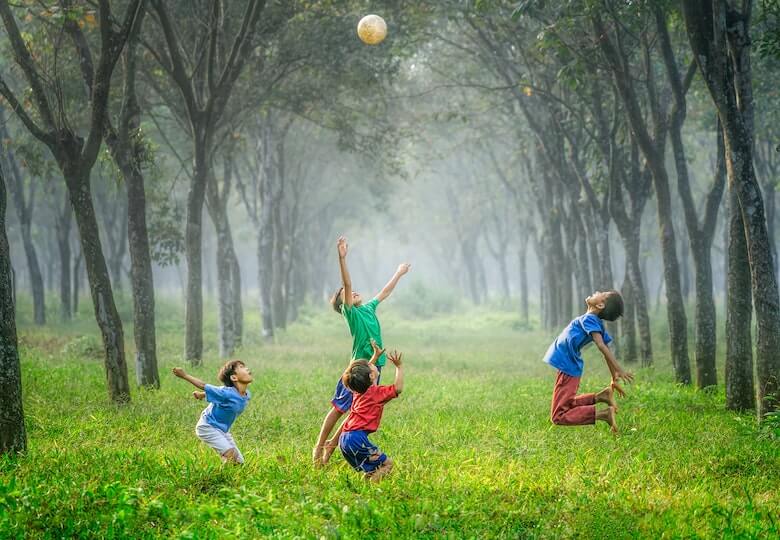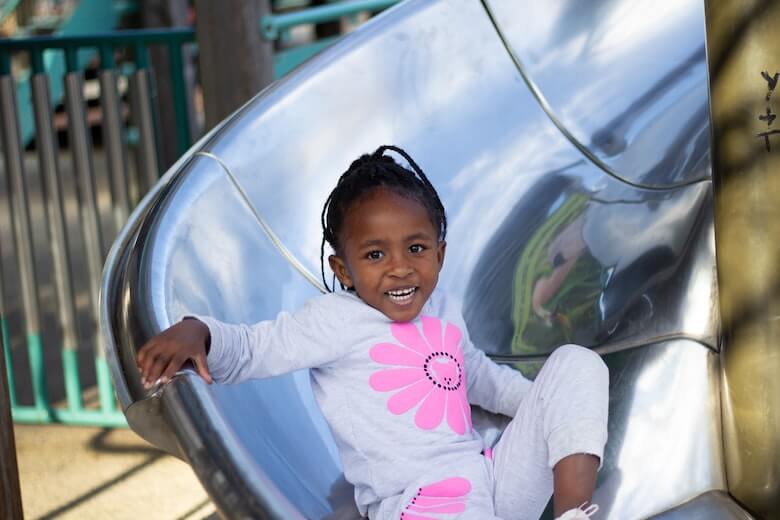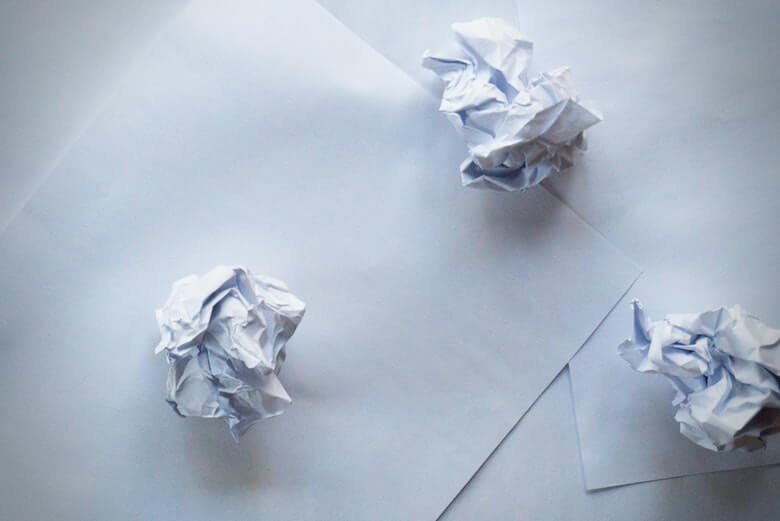
Have you ever seen a baby sitting in a high chair drop their food on the ground? They may look down at the floor and observe what just happened. Then, in awe, they may take another handful of food, and try dropping it again. This is NOT making a mess. This is a science experiment, and it is totally legitimate one too. Ask Isaac Newton!
Children love seeing what happens when they drop or throw objects. This is why gravity can be taught at a young age. In this article, we’ll explain how to teach preschoolers about gravity with simple lessons and fun experiments.
Get yourself primed to teach the physics of gravity to preschoolers
Gravity can become a really elaborate subject. But with preschoolers, we’re just teaching the basics of gravity. However, as the educator in the room, you may want to be prepared for a few ‘journalistic’ questions that may come up.
For example, we may think that our preschool gravity lesson will stop at “what goes up, must also come down.” But sure enough, a child in the classroom may start asking about outer space (which is another lesson on its own!). Or clouds. Or helium balloons. Or why things float on water.
These will be perfect teachable moments you’ll want to take advantage of.
So, without getting into the PhD-level complexities of matter, weight, mass and all the forces of the universe, you can check out the following resources to learn a little about how gravity works, in a way that appeals to children:
- Gravity Compilation: Crash Course Kids – Crash Course provides several, high-quality, educational videos on YouTube for free. They are a little more advanced than preschool-age knowledge, however. So you’ll want to absorb these fun facts, then teach them more slowly to your daycare or preschool classroom.
- Do Heavier Objects Really Fall Faster? (article by Wired magazine) – an adult-oriented but fun explanation about why heavier objects fall to the ground faster – on earth that is.
- How Gravity Works For Kids (animated YouTube video) – a rather well-explained video that is made for early learners. It helps to understand the fundamentals of gravity.
The above will get you started, but of course there is more to learn about gravity. For example, this water jar gravity experiment explains how air pressure overcomes the force of gravity. It’s by The Homeschool Scientist and it links to other more advanced physics experiments. If you think your preschoolers will ‘get it,’ give it a try!
Learn about Isaac Newton and his apple tree
There is nothing more classic in a preschool gravity lesson than learning about Isaac Newton and the epiphany he had when an apple fell on his head. Of course, Newton taught us a lot more about physics than gravity alone. However, for preschoolers, you can start with this story since it’s so simple. It also gets the point across clearly.
Now, there aren’t a lot of preschool-focused books on Isaac Newton and his apple tree experience. But, we did find children’s books that you can try. They may be more suited to first or second graders. To adapt them for your preschoolers, you can omit some parts, or focus on the images while improvising the story, for an early learning setting. The ones we found are:
The Gravity Tree: The True Story of a Tree That Inspired the World
Isaac Newton and the Laws of Motion (this one is a broader view of Isaac Newton’s accomplishments)
Who Was Isaac Newton? (this one is more about Isaac Newton’s life and accomplishments)
We also found an animated YouTube video that tells this story quite aptly for a preschool audience:
https://www.youtube.com/watch?v=h48BWDeBLno
And, below is digitally written story about Isaac Newton’s apple-tree ‘moment’ for young learners (in case you prefer the words alone):
Sir Isaac Newton and the Apple
Note: we do not earn any commissions from the links above, and do not recommend one resource over another. The resources above are only a result of our basic product research. Please do your own additional research to learn which ones suit your needs.
If you choose not to use a pre-printed book, you can take inspiration from the above video and website to create your own graphics or materials to tell this story during circle time. E.g. try felt shapes, or drawing the story on an easel as you tell it.
Here’s another idea: try combining this story with a lesson plan on apples, which our Langley, Coquitlam and North Vancouver daycare centres like to teach!
Do physical exercises to help preschoolers learn about gravity
During your gym time, circle time, dance class or preschool yoga class, ask children to do a few activities, to see how long they can stay in the air. These can include:
- Jumping as high as they can
- Standing on one leg
- Skipping on one leg
- Holding arms out sideways
- Bouncing a ball
- Throwing a ball sideways and then upwards
By using these gross motor activities, you can show children that everything that goes up, must also come down. Then you can open their minds to think about why that is.
Why do we get tired when we hold our hands up too long? What is pulling them down?
Why don’t we stay up in the air when we jump?
Why does our bouncy ball eventually stop bouncing and stay on the ground?
These are all explanations about the force of gravity. Gravity is invisible, but it draws everything towards the surface of the earth, where we stand and walk each day.
Make or use balance scales in the preschool classroom to show the impact of weight on gravity
Here’s a fun game: let’s see what objects in the classroom are heavier than others!
If your preschool classroom doesn’t have a balance scale, you can make one (this would actually make a fun craft for each child to make). We found this neat idea on the Go Science Kids blog, here.
It only requires a clothes hanger, some cups and some string. Hang the cups from two ends of the hanger, and place the hanger on a door knob or hook. Then, put objects into the cups to see which is heavier.
This is the perfect way to teach gravity to preschoolers or even toddlers. It’s simple, which their little minds need as a stepping stone to further knowledge acquisition.
Use the playground slide to let preschoolers experiment with gravity

Preschoolers actually play with gravity all the time. You know how? With slides! Whether going up or down a slide, they all know that the force of gravity pulling them down on the slide is hard to resist. That’s why they slip backwards when they try to climb it!
To teach preschoolers about gravity you can also try rolling toy cars down a slide, or rocks and wood chips. See which ones go faster!
Go outdoors for some nature-inspired gravity experiments!

Nature around us is full of examples of gravity. If you live near a forest or parkland area, that can be a perfect location to find leaves, rocks, twigs and even fallen trees.
This is when you’ll want to do some experiments to explain air resistance.
You can ask children to pick up a rock, twig, and a leaf. Then ask them to drop them at the same time, from the same height. Which one falls to the earth quicker? Of course it’s the heavier objects, like the rocks and twigs, right?
But why?
This is because of air resistance and mass. When an object has more mass, it can overcome air resistance faster. On the flip side, air in our atmosphere can keep lighter objects ‘floating’ for longer.
However, in space, where there is no atmosphere, there will be no air resistance. Then, the rocks and leaves will fall at the same time. An astronaut actually tried this on the moon!
If you are indoors, you can do this same experiment with classroom objects such as:
- Toy blocks
- Pom poms
- Ribbons
- Balloons
- Gloves
- Books
- Tissue paper
- Crayons
- Confetti
And so on.
Do paper drops to teach preschoolers about gravity and surface area

This is where things get a little intriguing. We now know that a rock will fall to the earth faster than a leaf, because the rock is heavier than a leaf. But, what if we take two pieces of paper. We crumble one up into a ball and leave the other one flat.
They both have the same mass, right? They are now just different shapes.
With your preschoolers, try dropping them both at the same time, and at the same height. But before you do, ask them which one they think will fall first.
Guess which one falls to the ground the fastest? The crumpled up ball!
But why? This is because of surface area. The flat piece of paper has more surface area to fight against air resistance, which we learned about with the rock and the leaf. So, the more surface area there is, the slower gravity will pull it to the ground (on earth’s atmosphere, of course!).
Make egg parachutes to teach preschoolers about gravity
Ok, now… let’s take this up a notch and have some REAL fun.
You can do a craft activity with your preschoolers to make parachutes. Attach parachutes to paper cups big enough to hold an egg. We found this on the Science Sparks blog. You can find the instructions here.
You know what’s next, right? We hope the children do!
You’ll need to find a high spot (preferably outdoors) to drop your eggs without parachutes, and then again with parachutes. Can the preschoolers save the eggs? This will be gitty and exciting.
Teaching preschoolers about gravity is fun!
No doubt, teaching preschoolers about gravity will be fun, since it’s a topic that comes naturally to them. They love throwing things in the air and watching them drop. Plus, since gravity is all around us, this type of lesson can be interwoven with other classroom activities, such as physical exercise, crafts or even other science lessons (like space and apples).
See more on our blog: